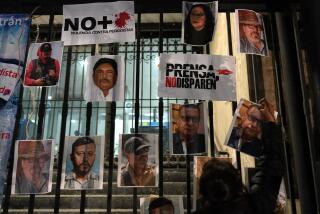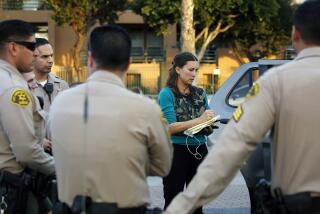‘Shield’ law faces a new test
- Share via
It’s not hard for most people to know what to do when they happen upon a crime, or its aftermath. They find a police officer and cooperate in any way they can.
Only it’s not always that simple for a journalist working on a story. And that’s not so simple to understand.
The latest fight over a claim of reportorial exceptionalism comes to us from San Francisco, where a college photojournalist documenting life in a sketchy neighborhood happened on a homicide scene.
The police wanted his photos, saying they would help solve the crime. The young photographer invoked the California reporter’s “shield” law to protect his unpublished material and, especially, his independence.
Police responded with a search warrant. They confiscated pictures, a camera and photo discs. Now the 22-year-old San Francisco State student is laying low, fearing for his safety if he is labeled a snitch, and fighting to get his pictures back.
The case has set off a lively debate. Some accuse the fledgling journalist of obstructing justice. Others embrace the higher principal he’s asserting. “Who will talk to journalists,” asked one reader on the San Francisco Chronicle’s website, “if it becomes common practice for reporters to hand their testimony over to police?”
It’s probably no surprise that I would take the photographer’s side, not because journalists should always win when it comes to balancing competing values but because I think the cops forced a 1st Amendment showdown they didn’t have to.
It all began April 17 when the photographer went to Hunters Point as part of a project to portray life in one of San Francisco’s most downtrodden neighborhoods.
The photographer -- whose name is being withheld because both police and his attorney say he could be in danger -- had visited the neighborhood for months and was taking pictures of a Friday afternoon dice game.
Police have not released details of what happened next, but the result was that one of those the photographer had gotten to know, 21-year-old Norris Bennett, was dead in the street.
The photographer called police and the victim’s family, according to his attorney, Jim Wagstaffe. But when police arrived, the student declined to answer most of their questions.
Although he is not a professional journalist, the courts have made clear that the shield law protects student reporters and photographers from having to disclose unpublished notes, photographs or observations.
California legislators wrote the law in the 1930s (it later became part of the state Constitution) because they realized that journalists can’t function -- persuading jittery subjects to talk or getting whistle-blowers to share confidential information -- if the sources believe their identities or statements might be revealed to authorities.
“My guy exposed himself to a difficult situation for a long time to report on an underserved community,” said Wagstaffe, who specializes in 1st Amendment cases. “If he gives testimony or pictures now and gets in harm’s way, the next three journalists won’t be able to go to a place like Hunters Point and gather important information.”
Anyone who has spent even a few days reporting in a rough neighborhood -- the kind that needs more attention, not less -- recognizes this isn’t merely lawyer-speak. Your credibility as a reporter and your safety rests on your ability to prove to the locals that you don’t work for “the man.”
Wagstaffe concedes that such a view, “from 30,000 feet,” can sound fairly highbrow and esoteric when compared to a cop’s street-level imperative to find a killer.
The only problem with the police argument in this case is that it’s far from clear that they don’t have other options.
Bennett wasn’t shooting dice by himself, so there must be other witnesses. The police have declined to comment on that and other details.
In addition, the young cameraman has said that he got pictures of the aftermath -- as paramedics arrived and began working on the mortally wounded Bennett.
“There is no indication at all that my client saw the homicide take place,” Wagstaffe said. “There’s also no indication at all that he has any photographs of that moment.”
Police served their search warrant April 27 and seized all sorts of things from the San Francisco State student’s apartment, even family pictures that had nothing to do with the homicide, Wagstaffe said.
The lawyer went to court this week to demand that the search warrant be quashed and the photojournalist’s possessions returned.
It’s not hard to imagine the rare instance in which a reporter might have an exclusive view of a crime and offer authorities unpublished photos or observations. I would certainly imagine supporting such cooperation if there were no other way to solve a serious crime or to prevent some imminent danger.
But recent history suggests that investigators don’t wait for last-resort circumstances to dragoon journalists as their involuntary deputies.
Video blogger Joshua Wolf spent more than seven months in prison a couple of years back when he defied demands to turn over his raw video of a chaotic San Francisco street protest in which a police officer suffered a fractured skull.
Wolf finally got out under a compromise, in which he released the video but avoided testifying to a grand jury about the protest or the identities of the protesters.
Bottom line: His video didn’t reveal anything that helped find the bad guys who attacked the officer, or who allegedly attempted to burn a police car. He told investigators as much before he spent 226 days in prison.
Congress appears poised to approve a federal shield law to give journalists the breathing room they need (and which is already in place in most states.)
One of the most difficult tasks in the age of independent bloggers and freelance videographers will be defining who is a journalist and therefore worthy of having their work material protected from unwanted disclosure.
One possible definition would include anyone gathering information for dissemination to a broad public, with an audience beyond one’s personal circle. It’s going to take a few court cases, and some time, to sort this one out.
A judge probably will have to settle the latest San Francisco controversy too, taking a hard look at the investigators’ blunderbuss approach to evidence collection.
The cops shouldn’t need a judge to tell them that the young journalist has the right to conduct his own, but no less important, search for the truth.
Follow-up: I spanked the New York Times last week for not disclosing the payments received by its journalists for speaking engagements.
That bit came after the revelation that star columnist Thomas Friedman got $75,000 to speak to a public agency in the San Francisco Bay Area. Friedman gave back the fee because the Times only allows journalists to earn such money from nonprofits and educational institutions.
Times Editor Bill Keller on Wednesday ordered his staff to do a better job of filing internal reports detailing how much they get paid for speeches.
Still no movement on getting the Times to publish those reports so we can all sniff out possible conflicts of interest.
Such transparency would be good medicine, not just for the New York Times but for all media outlets.
--
More to Read
Get the L.A. Times Politics newsletter
Deeply reported insights into legislation, politics and policy from Sacramento, Washington and beyond. In your inbox three times per week.
You may occasionally receive promotional content from the Los Angeles Times.











